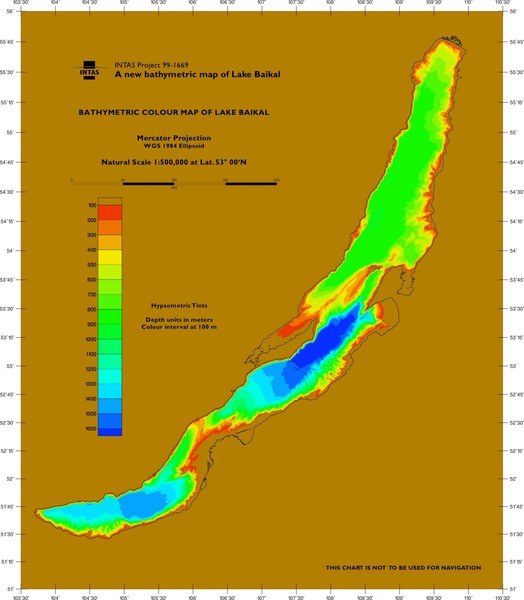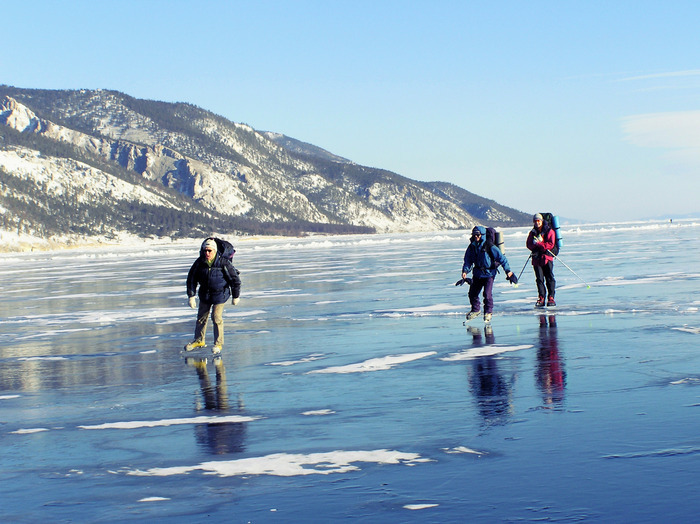Note: this takes place in a world populated by humanoid bears, where the population density in Siberia is much higher. The northern part of Russia is taken up by a country called Medwedia.
As said before, Medwedia takes up the northern part of Russia in our universe; both countries span eastwards up to the Pacific coast (Alaska belongs to Medwedia, a hypothetical Bering bridge will be discussed in another question).
Now... Medwedia and Russia share Lake Baikal, with two cities, Truz and Ignaz, being located on the opposing shores of the northern, Medwedian part of the lake. Truz and Ignaz are both large cities; and if a bridge would be constructed between them, there would be a full motorway that connects Medwed and Ostby.
Fig.1. - the Map. Red line is the Medwedia-Russia border. Northern yellow line is the Medwedian motorway from the Capital of Medwedia (1000km northeast of Moscow) to the city of Ostby (Pacific coast, 400km north of Vladivostok), southern yellow line is the Russian motorway from Moscow to Vladivostok. Northern purple line is a hypothetical road which follows the Northern coast of the lake, southern purple lines are hypothetical roads that connect to the Russian motorway which will be used as a transit road in this case, the purple line between Truz and the peninsula near Ignaz is the hypothetical Baikal bridge.
Now, (mid-20th Century), we want to connect the growing cities of Truz and Ignaz with a bridge. The bridge should consist of a motorway and rail tracks and should be usable all during all times of the year.
Is something like this possible at Lake Baikal?
The following main problems would arise during planning, design and construction:
Depth of Lake Baikal - I have heard that Lake Baikal reaches depths of up to 1642 meters at some points. The depth map shows that the northern part of the lake usually has depths of no more than 700-800 meters, but it is still very deep! I know that most bridges are constructed in relatively shallow waters. A solution would be planning the bridge so that the ridge (middle part of the lake) which has smaller depths is used and to install floating supporting structures.
Climate - The lake freezes over completely in winter. This could damage the bridge due to temperature changes and also due to forces enacted on the supporting structures by the ice as it expands due to the density anomaly of water. This could be countered either by the usage of special materials or moving parts that take up the pressure or by heating elements that would at least prevent the ice from cooling down too strongly, minimizing the pressure effects enacted by the density anomaly.
Length - The part of Lake Baikal where I want to build the bridge has a width of 60 to 70 kilometers. I know that bridges of this length exist, but could such a bridge be constructed if the depth and the climate is considered? And after all, did bridges of this length exist in the middle of the 20th century?
If a bridge can NOT be constructed under these circumstances, those alternatives which would allow for the connection of the cities of Truz and Ignaz as well as for travel between Medwed and Ostby:
Ferry in summer, ice in winter - Ferries are commonly used to shorten travel times and distances. However, this would be especially difficult in autumn and in spring: in Winter, the ice is strong enough so that heavy vehicles can cross the lake (the Transsib company used to place tracks on the ice in winter while using a ferry in summer), but in autumn and in spring when the ice is dense enough to disallow travel by ferry but not dense enough for driving or placing tracks, there would be a big problem.
Northern coast road - A road which follows the coast of the northern part of the lake would probably be less expensive than a bridge, but would mean that travel times are longer.
Transit road through Russian territory - This would again not need for bridges to be constructed and would allow for the infrastructure of the Russian motorway between Moscow and Vladivostok to be used; however, travel times would be increased, and most importantly, the crossing of the border into Russia and back again into Medwedia would be needed for a citizen of Medwedia to travel from Medwed to Ostby or from Truz to Ignaz. However, this should not be a big problem since the relations between Medwedia and Russia are good.
Tunnel - There could be good reasons why a tunnel is better than a bridge in this case; however, it would theoretically be even more expensive than a bridge or mean that the transport capacity would be even lower.
Now, I am asking you the following questions:
- Could a bridge like this be constructed with mid-20th century technology (before 1975)? If yes, what challenges would await the engineers of the bridge?
- How would the bridge be designed? Should it be a rail-only bridge or should it be a motorway bridge? How to counter the main problems which I have named?
- If such a bridge can NOT be constructed, why would it be the case? What alternatives would be the best ones?











